Researchers at GW have developed a novel triple-parametric optical mapping method that can effectively, accurately, and simultaneously measure metabolic, electrical, and contractile components associated with cardiac physiology. As a result, this allows effective clinical management of cardiac procedures especially with regards to one aspect known in the art as metabolism-excitation-contraction coupling (MECC). Further, the disclosed triple-parametric optical mapping method can effectively assist in the drug development process by means of effectively determining appropriate dosing for a subject while also accounting for toxicity considerations of the aforementioned dosing. The method also effectively allows analysis of repolarization-related parameters by effectively utilizing electromechanical uncouplers known in the art.
The disclosed invention can be implemented as either a system, a method, or a device as can be appreciated. The system or method can include various aspects including the following: (i) at least one optical system, for each of the metabolic, electrical, and contractile components associated with cardiac physiology, that can effectively, accurately, and simultaneously measure relevant parameters as can be appreciated; (ii) at least one optical source that can effectively, accurately, and simultaneously assist in measuring the parameters as can be appreciated. In one embodiment, the parameters include the following: transmembrane potential, intracellular calcium, and NADH.

Fig. 1 – One example of the disclosed invention
Applications:
- In the study of electrically excitable tissues such as muscles and neurons
- In testing dosage compositions, dosage forms, especially with respect to cardiovascular research
Advantages:
- Effective, accurate, and simultaneous measurement of metabolic, electrical, and contractile components associated with cardiac physiology
- Effective clinical management of cardiac procedures especially with regards to MECC